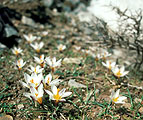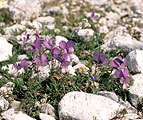 |
|
|
|
|
|
|
The alpine belt in the Mediterranean often starts at lower elevations than one would expect from latitude and overall climate. In other words, the climatic treeline is comparatively low (rarely above 2000 m, i.e. lower than in the central Alps, for instance), for which we have no good explanation. The climate is markedly seasonal with a wet, cold winter and a hot, dry summer. Millenia of landuse (largely goat grazing) have also shaped the alpine zone in most places. The following examples are from the Greek mountains on the islands of Crete, Kefalonia = Kefallinia and Samos. |
|
1 - Mountains of the central range in Crete, with Cupressus sempervirens (Cupressaceae) forming a pseudo-treeline at < 1500 m. |
|
|
2 - Mt. Kerki (in the background), Samos, with juniper formed pseudo-treeline at ca. 1000 m and characteristic thorny cushion vegetation plus intermixed spring annuals. |
3 - Crocus species in spring in the catchment of the Samaria gorge, Crete. |
4 - Viola cephalonica (Violaceae) above the Abies cephalonica treeline at 1600 m. |
5 - Sesleria (Poaceae) tussock grass and some tall herbs also resist the grazing pressure. |
|
6 - Thorny cushions of this type are characteristic features of the mountains of central Asia and reach their western limit in the Mediterranean (Astragalus sp. (Fabaceae) and Acantholimon sp. (Plumbaginaceae)). |
7 - Such cushions resist browsing but "pay" a high price: slow growth and overheating in summer (note the 47 °C in the cushion measured by a pocket thermometer pointing directly to the sun, so that it is not directly heated by the sun). |
8 - Centaurea spinosa (Asteraceae) |
9 - A fragmented cushion permits us to see that all stems emerge from one point. A massive tap root anchors the plant. |
|
Botanical Image Database of the University of Basel. E.g. search for Juniperus foetidissima. |
29 August 2011 |
||
| |
||









